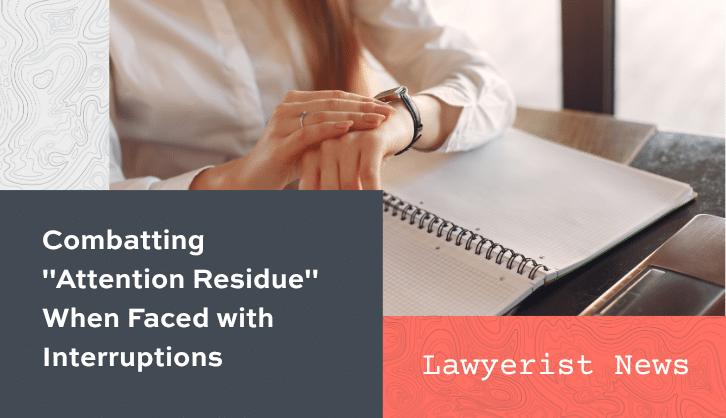Trendy work is rife with interruptions … from pressing consumer emails and calls to colleagues searching for enter. These interruptions fragment our time and a spotlight. Analysis revealed in Harvard Enterprise Overview by Professors Sophie Leroy and Theresa M. Glomb discovered that professionals are interrupted roughly each 6 to 12 minutes on common. Every interruption forces a psychological context change that may depart a portion of our consideration nonetheless “caught” on the unique activity, a phenomenon Leroy calls “consideration residue.”
In essence, consideration residue means a part of your thoughts continues to preoccupy itself with the earlier, unfinished activity whilst you try to deal with the brand new one. This leftover consideration impairs efficiency. You’re utilizing solely a part of your cognitive capability on the present activity which may result in missed particulars, poorer choices, and issue resuming the unique work. For individuals juggling a number of issues and deadlines, consideration residue invisibly drains your effectiveness.
The Prepared-to-Resume Plan: A Easy Answer
Leroy and Glomb’s analysis supply a sensible intervention to fight consideration residue: the “Prepared-to-Resume” plan. I’ve all the time referred to as this, “Observe the place you left off and what’s subsequent.” The “plan” is very simple and fast. When one thing or somebody interrupts you mid-task, take a second to jot down a quick be aware on the place you left off and what you propose to do subsequent on that activity. Basically, you allow your self a highway map for returning, a brief listing of subsequent steps, challenges left to deal with, or the subsequent motion to take whenever you come again. This tiny funding of time supplies cognitive closure, reassuring your mind that the preliminary activity will likely be accomplished later, so it could actually safely set it apart for now. By explicitly marking your home and plan, you give your mind “permission” to totally disengage from Job A and focus on Job B.
Key Findings
Leroy and Glomb examined the ready-to-resume technique in a sequence of experiments related to high-stakes decision-making. Individuals in a single lab examine had been assigned an preliminary activity after which interrupted with a secondary activity. One group was instructed to rapidly write a ready-to-resume be aware concerning the preliminary activity earlier than switching, whereas a management group switched duties with none such plan. The outcomes are placing and extremely related to the fixed pivoting that many people should do on daily basis.
Diminished “Consideration Residue” and Higher Focus
Those that created a ready-to-resume plan confirmed considerably much less consideration residue in the course of the interrupting activity. They might commit extra focus to the brand new activity at hand, whereas the no-plan group’s efficiency on the interrupting activity suffered (indicating their consideration was divided).
Improved Resolution High quality—79% Extra Prone to Make the Optimum Resolution
Those that had created a ready-to-resume plan for his or her authentic activity had been 79% extra prone to accurately select the highest candidate, which was the examine’s measure of the optimum determination, in comparison with those that didn’t plan.
Simpler Return to Unique Duties
Individuals who made a ready-to-resume plan had been much more prone to return to and efficiently end their authentic activity after the interruption.
Why this issues: A lot of our work typically includes managing a number of issues, deadlines, and unexpected consumer wants concurrently. The cognitive price of interruption (consideration residue) may be particularly detrimental the place particulars and sound judgment are paramount. The ready-to-resume method instantly addresses these points by preserving focus and continuity.
Suggestions
Pause and Plan (even for 30 seconds)
The second an interruption arises, take a quick pause to notice your standing on the present activity. Write a one-line abstract of what you had been doing and the subsequent step you supposed to take. If you’re the individual interrupting another person, give them the skilled courtesy and reminder to take the time they should be aware the place they left off and subsequent steps. If you’re the individual getting interrupted, inform the interrupter you’re simply taking a fast second to notice the place you left off and subsequent steps.
Give Full Consideration to the Interruption
When you’ve made your ready-to-resume be aware, absolutely interact within the interrupting activity.
Sources
Leroy, S. & Glomb, T. M. (2020). “A Plan for Managing (Constant) Interruptions at Work.” Harvard Enterprise Overview (June 30, 2020).
Leroy, S. & Glomb, T. M. (2018). “Job Interrupted: Inspecting the Results of Work Interruptions on Consideration and Efficiency” (Group Science).
Neilson, Ok. (2020). “The right way to Fight Consideration Residue.” HRM On-line – Australian HR Institute.
Final up to date July twenty fifth, 2025
